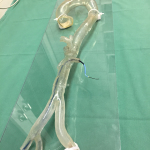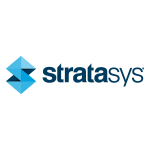German University Hospital Mainz Pioneers Surgical Planning for Life-Saving Vascular Surgeries With 3D Printing
Surgeons treat 53yr old woman turned down by several other hospitals
due to illness complexity, with surgical 3D printed models integral to
understanding the cause of the issue and best determining the type of
treatment required to successfully operate
MINNEAPOLIS & REHOVOT, Israel–(BUSINESS WIRE)–Stratasys
Ltd. (Nasdaq:SSYS), a global leader in applied additive technology
solutions, today announced that surgeons at the University
of Mainz Cardiothoracic and Vascular Surgery Department are using Stratasys
PolyJet 3D printing to transform the hospital’s surgical planning
process for complex, life-critical vascular cases. According to the
University hospital, the use of 3D printed models for surgical planning
has seen a significant reduction in costs at the institution when
designing and fitting implants – while the hospital reports relevant
time-savings during surgery, leading to an improvement in patient
outcomes.
As an internationally recognized Center of Excellence when it comes to
its Cardiothoracic and Vascular Surgery, the University Hospital Mainz
provides research and patient care in areas related to the heart, thorax
and blood vessels in the human body. The hospital treats several
patients suffering from life-threatening aortic illnesses needing
immediate attention and complex, patient-specific surgical treatment. According
to Prof. Dr. Bernhard Dorweiler, Head of the Department of Vascular
Surgery at University Hospital Mainz, the adoption of 3D printing is
playing a crucial role in elevating the standard of patient care.
“On average, CT scans with 1000-2000 images can be made per
vascular-related patient case, which the surgeons use to analyze and
diagnose the illness. This can be ambiguous and time-consuming when the
issue is complex,” says Prof. Dr. Dorweiler. “With 3D printed models, we
can quickly understand the individual patient anatomy and best determine
the type of treatment required to successfully treat it.”
This was exemplified in a recent case whereby Prof. Dr. Dorweiler and
his team were approached by a 53-year-old woman who had already been
turned down by several other hospitals in Germany and beyond – such was
the complexity around the illness and the potential risk of operation.
Due to an aortic malformation close to the heart, the patient was
suffering from a bulging blood vessel on her neck. Recognizing the need
for urgent medical attention, Prof. Dr. Dorweiler and his team reviewed
CT Scans, however the results did not provide the level of clarity
required to make an accurate diagnosis.
“Looking through the CT Scans, it was impossible to clearly visualize
the anatomy,” says Prof. Dr. Dorweiler. “So we decided to 3D print a
model, and it was then for the first time that it became clear what the
origin and magnitude of the problem was. Not only did we use the model
to explain our findings to the patient to increase her compliance for
the planned 3-step operation, but we even took it into each of the three
surgeries as a point of reference during operation, which was crucial to
the successful outcome.”
Practice-makes-perfect approach saves time and money
To date, treatment of complex aortic illnesses with the endovascular
method has been a difficult procedure, with surgeons relying on a
monitor to implant a small wire-mesh tube (stent) through the arteries
to be placed at the affected area of the aorta. In a recent case, Prof.
Dr. Dorweiler and his team faced this challenge with a very complex case
of aortic arch aneurysm. Requiring an intricate implant, the team
undertook a pre-operative simulation of the surgery using a stent
prototype and 3D printed aortic arch model of the patient. This process
has since been repeated across several cases, with surgeons able to
practice surgery on the model repeatedly ensuring the correct design and
fit of the stent implant the first time – significantly reducing time
and cost in the operating theatre.
“As pointed out in current published studies, there are savings in
operating time of 5-45 minutes when using 3D printed models prior to
surgery,” says Prof. Dr. Dorweiler. “Research is still ongoing, but if
you take an average surgery time of 2-4 hours, you are looking at time
savings of up to 40%. When you are dealing with complex vascular cases
every day, these time-savings can be the difference between life and
death.”
Training future vascular surgeons for success
At the forefront of German medical research and development, the
Vascular Surgery Department at the University Hospital Mainz has an
extensive training facility, in which 3D printing is integral.
“We use the Stratasys
Eden260VS 3D Printer in our BiomaTicS research platform to produce
models of aortic anatomies from real-life cases, so that we can use them
to teach future vascular surgeons how to successfully perform complex
endovascular surgeries,” says Prof. Dr. Dorweiler. “With the ability to
3D print patient-specific aortic models in clear transparent material,
the trainees can practice endovascular procedures and learn difficult
Wire-Skills using the accurate replicas of blood vessels. For
healthcare, it is crucial that we continue to leverage the capabilities
of 3D printing for medical training, education and research for future
breakthrough-implementation.”
Rene Martin, Business Manager Healthcare EMEA, Stratasys, concludes:
“The pioneering use of 3D printing witnessed today underpins why the
University Hospital Mainz is at the forefront of German medical research
and development. Leveraging high resolution 3D printing, the ability to
replicate patient-specific anatomy is enabling physicians and surgeons
to quickly plan, practice and determine life-saving surgical approaches
– not only to improve patient care and outcomes, but also mitigate risk
and reduce costs.”
About Stratasys
Stratasys
(NASDAQ: SSYS) is a global leader in applied additive technology
solutions for industries including Aerospace, Automotive, Healthcare,
Consumer Products and Education. For nearly 30 years, a deep and ongoing
focus on customers’ business requirements has fueled purposeful
innovations—1,200 granted and pending additive technology patents to
date—that create new value across product lifecycle processes, from
design prototypes to manufacturing tools and final production parts. The
Stratasys 3D printing ecosystem of solutions and expertise—advanced
materials; software with voxel level control; precise, repeatable and
reliable FDM and PolyJet 3D printers; application-based expert services;
on-demand parts and industry-defining partnerships—works to ensure
seamless integration into each customer’s evolving workflow. Fulfilling
the real-world potential of additive, Stratasys delivers breakthrough
industry-specific applications that accelerate business processes,
optimize value chains and drive business performance improvements for
thousands of future-ready leaders around the world.
Corporate Headquarters: Minneapolis, Minnesota and Rehovot, Israel.
Online at: www.stratasys.com,
http://blog.stratasys.com
and LinkedIn.
Attention Editors, if you publish reader-contact information, please use:
- USA 1-877-489-9449
- Europe/Middle East/Africa +49-7229-7772-0
- Asia Pacific +852 3944-8888
Contacts
Stratasys
Arita Mattsoff, +972-74-745-4000 (IL)
[email protected]
Joe
Hiemenz, +1-952-906-2726 (US)
[email protected]
or
North
America
Stratasys
Craig Librett, +1-518-424-2497
[email protected]
or
Europe
Incus-Media
Jonathan
Wake / Miguel Afonso, +44-1737-215200
[email protected]
or
Asia
Pacific and Greater China
Stratasys AP
Sophie Su, +852
3944 8888
[email protected]
or
Japan
and Korea
Stratasys Japan
Aya Yoshizawa, +81 90 6473 1812
[email protected]
or
Brazil
GPCOM
Clezia
Martins Gomes, +55 (11) 3129-5158
[email protected]
or
Mexico,
Central America, Caribe and South America
Stratasys Mexico
Yair
Canedo, +52 55 4169 4181
[email protected]










